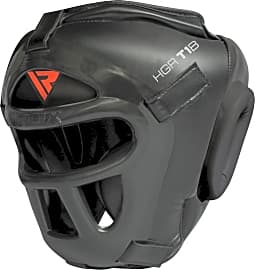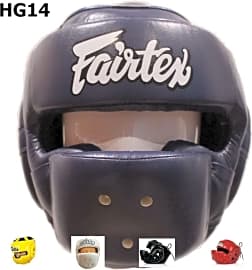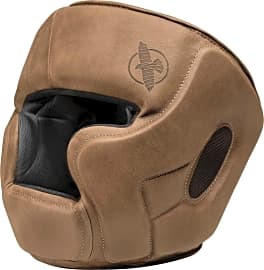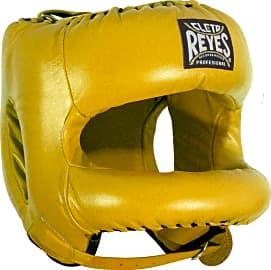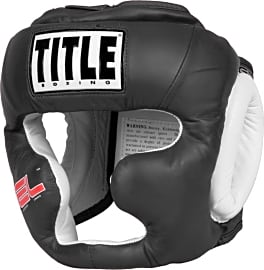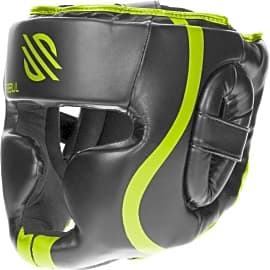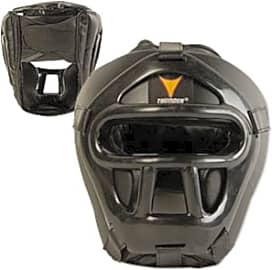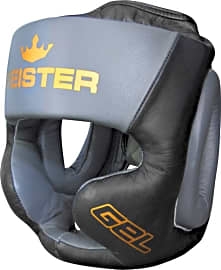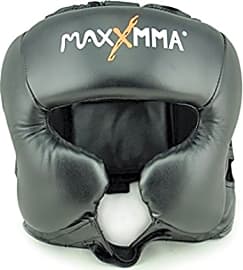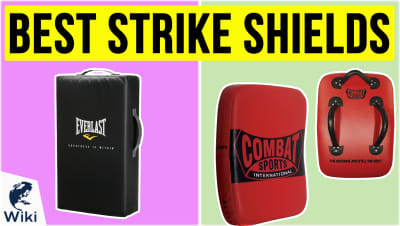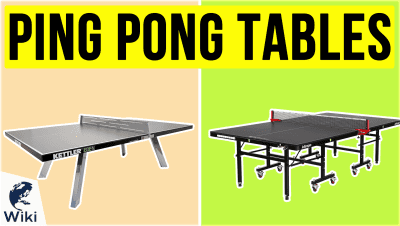The 10 Best MMA Headgear

This wiki has been updated 45 times since it was first published in September of 2015. Planning on getting into the ring or octagon in the near future? Then the least you can do is protect your head — and brain — with some MMA headgear. Our selections for this category include fully-enclosed models with cages that are suitable for serious fighters engaged in full-contact sparring, as well as open-face options that are serviceable for lighter, controlled fitness training. When users buy our independently chosen editorial choices, we may earn commissions to help fund the Wiki.
Editor's Notes
April 07, 2020:
During this round of updates, while we removed the Venum Elite and Venum Challenger 2.0 due to availability issues, we also eliminated the Gold BJJ and Everlast Everfresh, in order to make room for new high-end inclusions. Some of our new additions are the Fairtex HG14 – which features a faceguard with a steel cage, the Cleto Reyes Protector II – a Mexican-made model with a rounded faceguard that does a better job of protecting your mouth than nose, and the Hayabusa T3 LX – which is made of full-grain Italian leather.
A few things to look for in this category:
Cushioning: More cushioning means less impact against your skull, which in turn means less concussions and headaches, which is obviously desirable. However, there also tends to be an inversely proportional relationship between cushioning, and visibility and ventilation – so a balance needs to be found between the two.
How much cushioning you realistically need depends on the kind of training you're doing, as well as your tolerance for abuse. As a baseline, you’ll almost certainly want headgear that protects your forehead and ears, which most of them do. On top of this, with so many models on the market that offer decent cheek protection without significantly impacting your peripheral vision, I’m of the opinion that cheek cushioning is a must, as is presently reflected by all of our selections. Users engaged in heavy, full-contact sparring might also want to consider options like the RDX Maya Hide or ProForce Thunder that feature protective cages. However, your opponents may take issue with this, as they aren’t the most fun to hit, so extend a common courtesy and run it by your training partner before you cage up.
Visibility: The flipside of wearing a cage, or even headgear with cheek cushioning, is that it might affect your visibility, which will almost certainly mean you’re eating more punches. I realize that this contradicts my previous assertion regarding the necessity of cheek cushioning, but all models are different and none are perfect, so it’s about finding an option that offers you the right balance of protection and visibility. Also, it’s important to find headgear that fits you just right, so it stays snug even after you take a hit. Nothing’s worse than swallowing a hard hook and winding up with your ear guard over your eye. Fairtex models like the Fairtex HG14 and Fairtex HG10 have an excellent reputation for staying put when they’re strapped on properly.
Ventilation: This might seem like the last thing you’d be thinking about when you’re in the gym, fighting for your life, but it really isn’t. In a culture that already romanticizes cardio training to the point of vomiting, the frustration of stifling equipment can’t be overstated. Well-ventilated gear helps keep you comfortable, allowing you to push yourself harder to take your training further.
This is another consideration that comes into effect when you’re trying to determine just how much face protection you want, as well as how much ear protection you need. While models like the Title Full Face have large ear openings supplemented by oversized cushioning, others like the MaxxMMA Black leave much less room for air to get in, and the Hayabusa T3 LX actually has the ear completely covered by vented gel foam.
My personal strategy has always been to pick models with good ear and cheek protection, but a well-ventilated top, as the top of the head seldom comes under fire – except in the case of a strong overhand punch or a rarely-used axe kick. Most of our selections allow quite a lot of air in up top. Although some, like the RDX Maya Hide, are also covered by quite a lot of cushioning.
A Brief History Of MMA Headgear
Headgear is regarded as especially important thanks to its concussion prevention potential.
The earliest mixed martial art was invented in ancient China by military generals and soldiers.
Called Shuai jiao, this ancient style of wrestling and Kug-Fu incorporated grappling techniques that are regarded as precursors to contemporary judo and jiu-jitsu. Shuai jiao also permitted kicking, punching, joint locks, finger locks, leg sweeps, leg locks, and the brutal, but effective close-range trapping techniques perfected by Han Chinese soldiers in combat with enemy soldiers.
In ancient Greece, there was a similar sport known as pankration. This competition, which was featured at the 33rd Olympiad of 648 B.C.E., combined grappling and striking in a manner similar to modern mixed martial arts. Pankration evolved from the already-established Greek boxing and wrestling traditions, and barred only biting and gouging. Pankratiasts, as the sport's fighters were known, fought until one opponent could not continue, or submitted by raising an index finger. Pankration was later passed on to the Romans.
Contemporary mixed martial arts traces its roots back to the mixed-style contests that were popular throughout Europe, Japan, and the Pacific Rim during the early 1900s.
In the early 1990s, a Brazilian competition known as Vale Tudo was brought to the United States in the form of the Ultimate Fighting Championship. This dangerous style was eventually made safer, and the door was opened to practitioners of all styles, adding to the burgeoning organization's intrigue. In 2001, UFC changed ownership, and under new leadership it experienced an era of unprecedented success.
Actor and MMA practitioner Bruce Lee was at least partially responsible for the popularity of martial arts in the 1960s and 1970s. UFC president Dana White called Lee the "father of mixed martial arts" in 2004, crediting Lee's Jeet Kune Do philosophy with inspiring a generation to seek multi-disciplinary training.
While many competitions throughout the centuries would fall under the mixed martial arts umbrella, the term may only date back to 1993, when television critic Howard Rosenberg used it while reviewing UFC 1.
Modern mixed martial arts reached peak popularity in the mid- and late-2000s, when a series of UFC events captured the public's attention like never before. Chief among these blockbuster fights was a rematch between then UFC light heavyweight champion Chuck Liddell, and former champion Tito Ortiz. For the first time, mixed martial arts events were rivaling and surpassing even the biggest boxing events in Pay-per-view sales.
Modern mixed martial artists often train with head gear, heavy gloves, strike shields, and shin protectors to limit their injury exposure. Headgear is regarded as especially important thanks to its concussion prevention potential.
Similarly, amateur mixed martial arts is practiced with protective gear that includes shin protectors and larger MMA gloves.
MMA And The Law
The legal status of mixed martial arts varies by country.
In the United States, professional MMA is governed by the Association of Boxing Commissions, which permits competition in every American state. In 2012, MMA attained national sport status in Russia, making it legal and encouraged.
Despite the ban, there were nearly fifty MMA gyms in Norway in 2012.
While modern MMA is legal in much of the world, some countries specifically prohibit its practice.
For example, in 2012 the Sports Authority of Thailand banned all MMA competitions, citing the potentially damaging effects the sport could have on the country's native Muay Thai industry.
In Norway, any sport that involves scoring or winning with knock-outs is banned. Despite the ban, there were nearly fifty MMA gyms in Norway in 2012. In Norway competitions follow a strict set of rules that limit the kinds of strikes a competitor is permitted to make.
France has a similar position, and currently bans all full contact MMA competition. MMA bouts in France do not permit striking on the ground, and include several other limitations.
While not illegal, MMA is not recognized by the government as a sport in India. This means any organized MMA bouts are regarded as street fights, with respect to the law.
The Professional MMA Landscape
With many hundreds of MMA promotions and organizations throughout the world, making sense of the professional landscape can be daunting.
The most popular and successful modern MMA organization is the UFC, which came to mainstream prominence around 2006.
In 2007, the UFC merged with Pride FC, effectively eliminating its largest competitor.
In 2007, the UFC merged with Pride FC, effectively eliminating its largest competitor.
Currently there are three other organizations that regularly feature top-ranked fighters on their cards: The California-based Bellator MMA, Singapore's One Championship, and Invicta FC, headquartered in Enka, North Carolina.
Beyond those four organizations, there is little competition for the eyes and ears of the worldwide MMA viewing public. However, some organizations have risen to regional prominence, and may someday threaten UFC's stranglehold on the industry.
Among them is London's Cage Warriors Fighting Championship, the Russia-based M-1 Global, and Jungle Fight, which stages fights chiefly in Brazil.
Below the organizations in the global hierarchy are many hundreds of MMA training facilities. Based on the success of the fighters they produce, the most effective gym in the world is Nova Uniao, located in Rio de Janeiro, Brazil. The second most accomplished gym in the world is the Albuquerque, New Mexico-based Jackson-Winkeljohn MMA gym.


